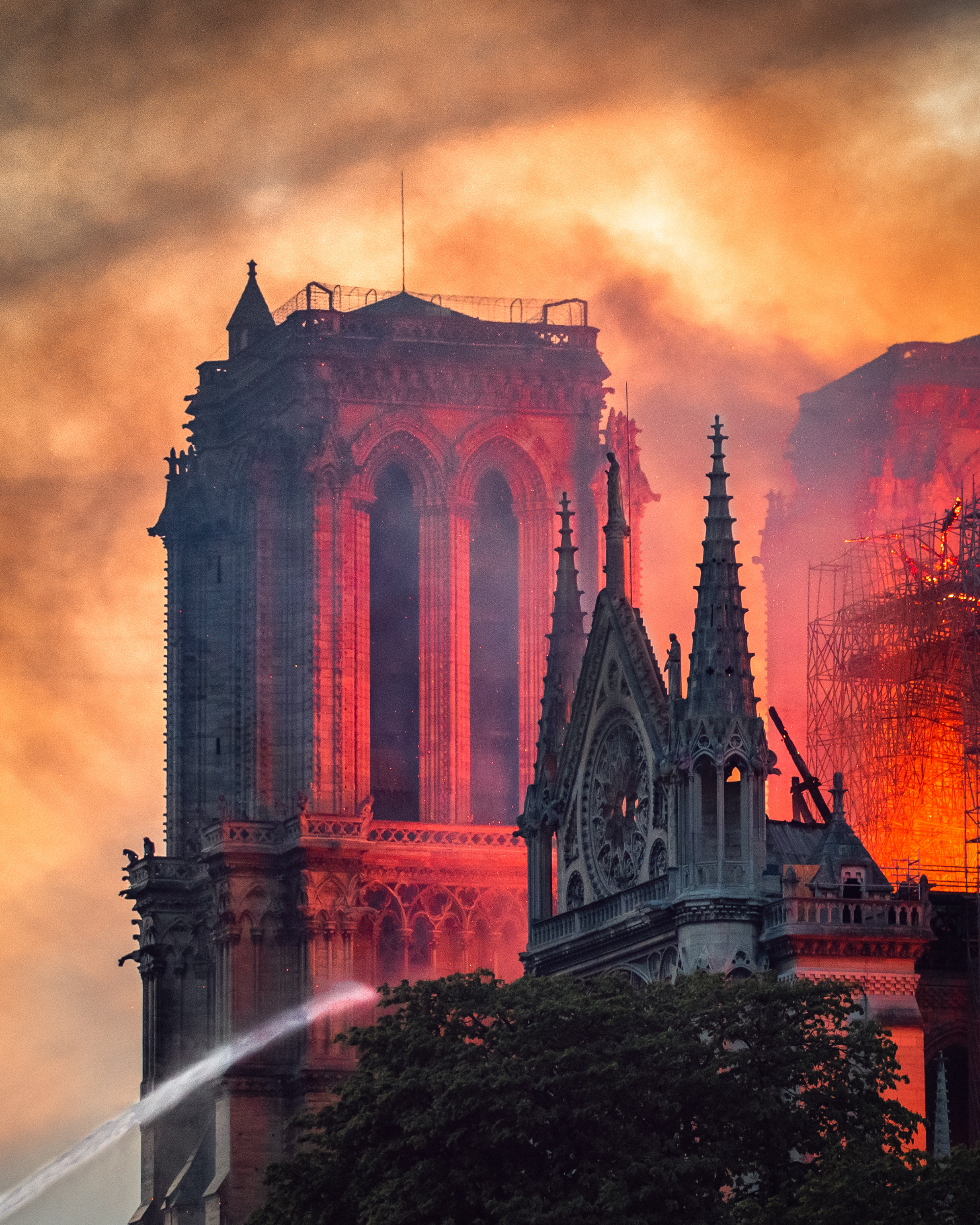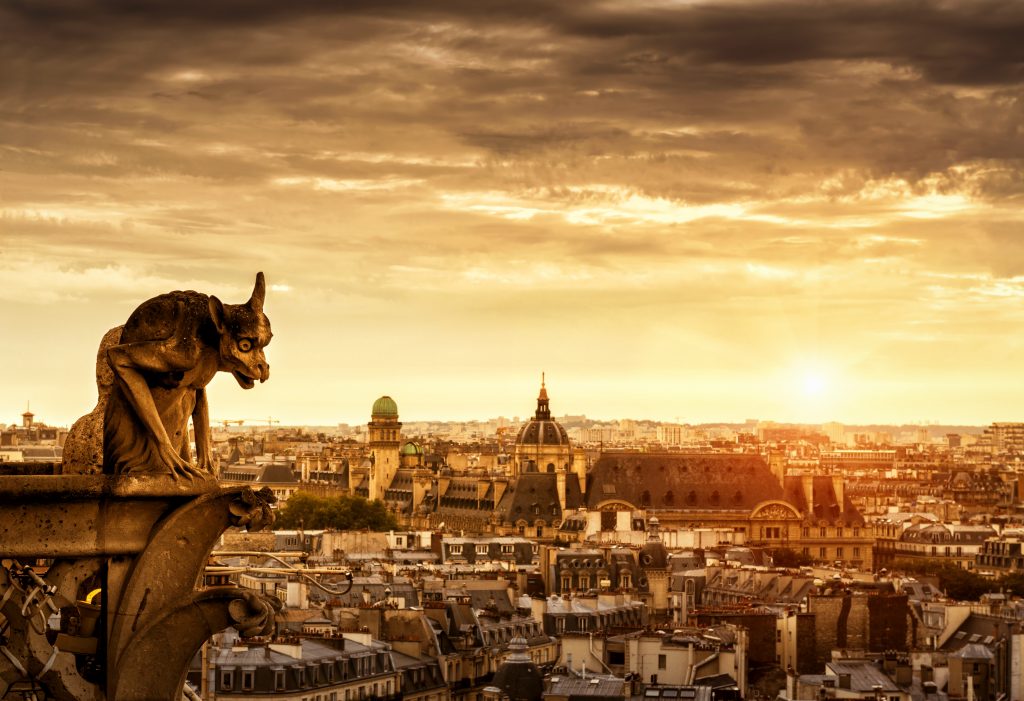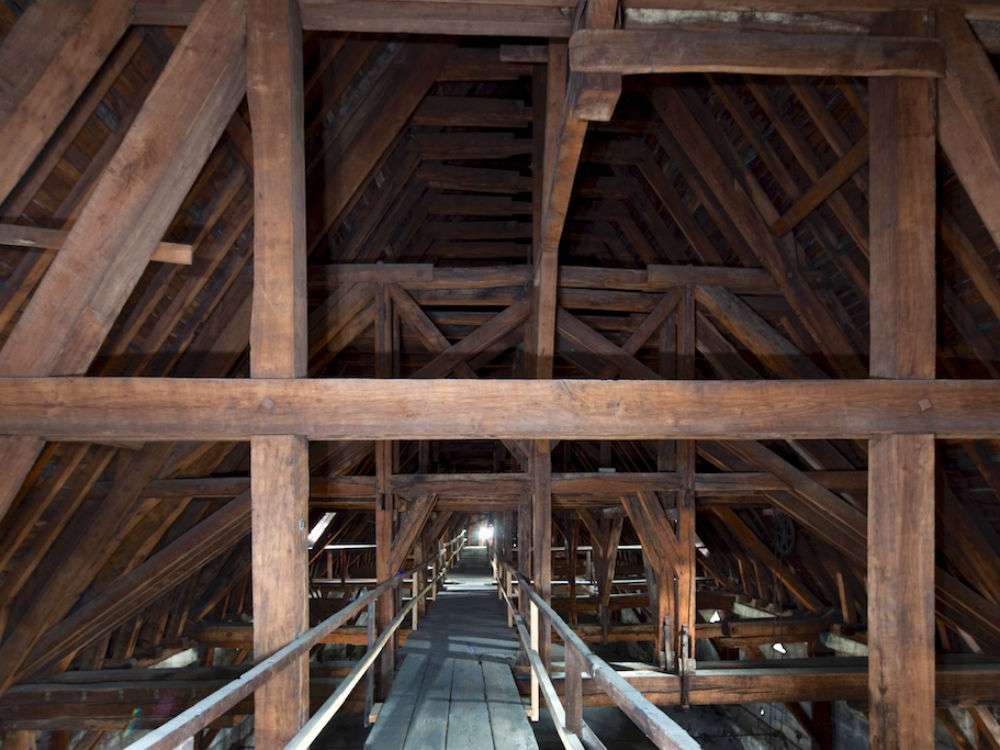Notre-Dame de Paris

Now that the fire is out,
Now that we know that the shell is intact, and the work of the medieval stonemasons has stood the test of time,
Now that we know that the bell towers are still part of the skyline,

Only now is it possible to look at the mesmerizing images of the fire as it burned, when it seemed the cathedral could not possibly survive, and once again experience the joy when it was announced that the fire was contained and the structure had held.
The fire that nearly destroyed Notre Dame Cathedral a little over two months ago has become an indelible part of its history as a structure. Some wish it to be rebuilt exactly as it was; others wish to mark this moment in time with a “contemporary architectural gesture,” as Emmanuel Macron has phrased it. Conversation has centered around those areas that are gone: the nineteenth century spire, the roof, and the “forest,” or wooden scaffolding inside, half of it from the thirteenth century, and half from the nineteenth. The forest no longer exists, except in photos and in the digital imaging that would allow it to be rebuilt.

Notre Dame had been at the start of planned restorations, at an estimated total cost of 60 million euros. The spire accounted for 11 million euros, and was surrounded by a complicated scaffolding. It was estimated that the work would take 4 years. In preparation, sixteen statues at the base of the spire, representing the apostles and evangelists, had just been removed to a place of safekeeping (Le Figaro, April 16, 2019). The results of the investigation on the cause of the blaze, begun the night it occurred, were released in late June: either a poorly extinguished cigarette or an electrical short circuit. Criminal arson has been ruled out (Libération, June 26, 2019).
On the night of April 15, 2019, one of the regular organists, Johann Vexo, was playing for the evening service. He had played in Notre Dame for fifteen years, and on this occasion, several hundred people, both worshippers and tourists, were inside. They began the service at 6:15 p.m., and at about 6:30, the alarm went off. Neither he nor the priest had ever heard it before–a siren, followed by a message, in both French and English, that told everyone to leave. He believed it must be a mistake; there was no smell or sound of burning. So he simply walked to his home, ten minutes away, just in time to receive a phone call from a friend in another country, who had seen the news on social media (Ouest-france, April 16, 2019).
The spokesman of the fire department, Lieutenant Colonel Gabriel Plus, reported that they got their first call at 6:43 pm and were there in under ten minutes. They are accustomed to saving lives; here, they had to make choices about the structure. Their first decision was to protect the bell towers. A considerable number of firefighters were actually inside, with one unit salvaging whatever they could as others fought the fire (Le Figaro, April 18, 2019). He expanded on these decisions the following morning, revealing just how close they had come to losing the cathedral: What’s above us? What should we do first? “And with all of that, we have to make good choices rapidly in taking account of the wind, the works, the hydraulic means at our disposal.” He noted further that their priority had been “to save the two bell towers . . . and the two bell towers were saved. Imagine it: the wood in the bell towers weakening, the bells falling, that was our greatest fear! At the beginning of our action, it was not impossible to believe that the structure itself would collapse” (Le Monde, April 16, 2019).
An American firefighter, who was touring the church of Sacre Coeur on the heights of Montmartre, captured this image.
At 7:39 pm (all these are Paris times), President Donald Trump tweeted a suggestion that they might use “flying water tankers” (Le Monde, April 15-16, 2019). Other tweeters suggested a helicopter instead, and the official twitter account of the Civil Security office responded just after 9 pm: “Helicopter or plane, the weight of the water and the intensity of the drop at a low altitude could weaken the structure of Notre Dame and cause collateral damages to the surrounding buildings.” Because of location, however, they were able to use water from the Seine, pumped to them from a fire boat.
The following footage was taken by the fire brigade itself (400 firefighters, 200 backup), and shows the intensity of the blaze, particularly around the complex scaffolding built to carry out the planned renovations on the spire; they later became part of the conspiratorial rumors. One can also see the multiple hoses from multiple sources, the entry into the cathedral by some, while others were on hydraulic lifts; one can also glimpse the “robot colossus,” a remotely controlled machine that is able to withstand high temperatures while sending video of the scene to its handlers; they also received information about the progress of the fire from airborne drones (Le Figaro, April 18, 2019). And finally, in the images of the burning spire, one can see at the very top the tiny coq gaulois, the Gallic Rooster, a symbol of France that went down with the rest.
When it was clear that the spire was about to fall (at approximately 7:50 pm), all units were pulled outside; robot colossus remained (Le Figaro, April 18, 2019.
At about 8 pm the last bateau-mouche was going down the Seine, its recorded message still playing, still pointing out Paris monuments (Le Monde, April 16, 2019).
At approximately 9:35, local time, the Archbishop of Paris sent a message to all the priests of the city, telling them that the charpente, or “forest,” was gone, as were the roof and the spire. He asked them to pray, and if they wished, to sound the bells of their own churches.
A number of church bells sounded throughout the city, as if in distress, or mourning, as the following capture of Sacre Coeur suggests:
Le Monde kept up a running commentary that night and early the next morning that included tweets, updates, statements, and reader questions; it also provides a timeline for the evening.
At 8:06 Prime Minister Édouard Philippe arrived at the Cathedral, with President Macron and his wife Brigitte appearing at 8:31.
At 8:59 it looked as if the north bell tower was burning. [The biggest bell, the 13-ton Emmanuel, is in the south tower; the towers are 226 feet tall.] It was understood that the collapse of one or both towers would lead to the collapse of the entire cathedral.
At 9:39 pm Édouard Philippe tweeted, “Our sorrow is beyond words but we’re still in the fight. This evening the firefighters are heroically combatting the fire, to save what can be saved.”
Just before 10 pm, the newspaper La Croix reported that they had been told by a fireman that “the next hour and a half will be determinative.”(Le Monde, April 15-16, 2019).
Finally, at about 11pm, the commandant of the sapeurs pompiers reported that, “Two thirds of the forest is destroyed. But we can consider the two towers saved. The structure is preserved (Le Monde, April 16, 2019). There were hotspots and pockets of flame, and it was not until 4:45 am that the fire was completely under control (Le Figaro, April 16, 2019).
Macron was able to enter the cathedral, briefly, at just before midnight. He returned, obviously moved, to promise that France would rebuild.
Laurent Nunez, undersecretary of the Ministry of the Interior, appeared on BFMTV early on Tuesday morning and stated that the fire had been “mastered” but not totally extinguished; there were some areas in the cathedral that were still smoldering. They were beginning to examine the entire structure to determine its stability. He added his praise for the Paris firemen, who, “with great courage entered the towers so they could attack the fire from inside, to prevent the cathedral from collapsing. Without this action, taken at the risk of their lives, it would have collapsed without question” (Le Monde, April 16, 2019).
Philippe Villeneuve, the chief architect of historic monuments in France, went into the rubble, after a sleepless night, looking for this–and he found it, the only part of the spire that remained intact:
Emmanuel Macron had been planning a televised address on the night of the fire, to reveal the proposals of his “Great Debate,” the series of conversations organized throughout the country as a response to the Gilets Jaunes. He postponed it, obviously, but gave an address to the country the following evening:
For a brief time, the nation had come together in a common sorrow and a determined purpose.
And then things went back to normal.
It started with Macron’s determination to rebuild within five years, “more beautiful than before.” Architects, historic preservationists, builders, weighed in with concerns. The time would likely be measured in decades rather than years. And was it not already beautiful? What did he mean? François Xavier Bellamy of Les Républicains, whose political identity is very tied to his devout Catholicism, complained of Macron’s “mania for disruption,” suggesting that a little “humility” would be in order. The hashtag #netouchepasànotredame (Don’t touch Notre Dame) was born (L’Express, April 18, 2019).
On April 17 came the announcement from Prime Minister Philippe of the contest for a possible redesign of the beloved spire: “The international contest will settle the question of whether we should build a new spire, whether we should rebuild the spire that was designed and built by [Eugène] Villet-le-Duc, in identical fashion, or whether we should . . . endow Notre Dame Cathedral with a new spire adapted to the techniques and challenges of our era” (The Local, April 17, 2019). For most of its history, Notre Dame had not had a spire; charged with its design in the nineteenth century, Viollet-le-Duc had researched gothic architecture and had created a design that everyone had hated, then loved. The spire immediately became the chief subject of controversy.
Only two weeks after the fire Macron received a petition, signed by 1,170 conservators, architects, professors, and art historians, asking him to give the experts time to evaluate the situation fully, and reminding him that France had taken the lead in the 1964 Charter of Venice, which had set global standards for historical preservation Le Figaro, April 29, 2019). A round table held by the Academy of Architecture, a gathering of specialists in historical monuments, came down strongly against any modification (Libération, April 29, 2019).
The alarm became greater when the promised “law of exception” for Notre Dame was introduced in the National Assembly on May 10. Macron has a solid majority in the Assembly, but even so the debate went on for 13 hours, into the morning of May 11, and was adopted by 32 votes for, 5 against, and 10 abstentions (most of these from Macron’s party) (Le Monde, May 11, 2019). (There are 577 deputies in the National Assembly.)
The law had a more difficult time in the Senate, which stripped the most controversial features away from it. Article 9 allowed the government to create by ordinance, in other words by executive action rather than law, what was described as “a public establishment to conduct the studies and the work of restoration.” The Senate, from all sides, preferred this work to be done by the regular Historic Monuments bureaucracy, composed of experts under the direction of the Ministry of Culture–in other words, through the regular governance channels–as opposed to an ad hoc committee that the president would choose. (An aside: this problem sounds rather familiar to those of us in academia.) Also gone from the Senate version was the explicit permission for the construction to bypass the usual rules, including municipal, environmental, construction, heritage preservation, and other regulations in order to meet Macron’s five-year deadline. The Senate struck this out, and also added to the law a requirement that the reconstruction should be faithful to “the last known visual experience” before the fire; and added as well that even the use of different materials would have to be explicitly justified (Le Monde, May 28, 2019).
In a last minute plea for this bill, Macron had attempted to reassure them and to make a case for his vision, calling for “an inventive reconstruction” inspired by what Viollet-le-Duc had done in the 19th century, which he described (probably to the irritation of all) as “an alliance of tradition and modernity, a respectful audacity”Le Monde, May 28, 2019.
In the meantime Nicolas Dupont Aignan had a rare moment of being with the majority. Dupont Aignan, who describes himself as “Gaullist” and is the founder, and sole member in the National Assembly, of Debout la France (France Arise), also the sole presidential candidate from 2017 to endorse Marine Le Pen in the second round, made a good case for the opposition (aside from the suggestions of conspiracy and attacks on Macron).
Dupont Aignan makes a reference to a number of possibilities he has seen in the newspapers. Le Parisien pulled them together:
And here’s another one.
The ecological moment dominates many of these ideas, and some are quite beautiful. Will fidelity to the past win out? At least we know that there is one design that no one will get behind. (But if someone has a team called “the Flames,” and needs a stadium sign, it perhaps has a future.)
The realities of the task may make Macron’s five year deadline (for the Paris Olympics, 2024) go away. As of mid-June, the work on the cathedral was proceeding cautiously. Franck Riester, Minister of Culture, stated that they were still stabilizing the structure and drying it out, sifting through the debris and looking for signs of fragility. The massive scaffolding built around the spire, still quite visible, would also have to be taken down. Work on reconstruction could not start until 2020 at the soonest (Le Parisien, June 14, 2019). The scaffolding, it should be noted, has been the center of numerous conspiracy theories, with internet rumors that the scaffolding had been the source of the blaze. Philippe Villeneuve, the head architect for Historic Monuments, explicitly defended Europe Echafaudage. And the accusation seems unlikely for at least two reasons: the scaffolding is made of steel; it’s still standing (Le Monde, April 26, 2019).
And the law of exception, which nobody favors? When the two chambers are in disagreement, the bill goes to a commission d’entente, composed of seven selected members from each house. They met on June 5, for less than an hour; they could not come together on Article 9 (Le Monde, June 5, 2019). If the commission can’t come together on a shared draft, the final say belongs to the National Assembly. As of June 25, the law was still being worked on by the commission (francetvinfo, June 25, 2019.
Finally, there is this oddly haunting video of a tour through Notre Dame five and a half months before the destruction of the forest and the roof. We can see the statues around the spire, taken down before the work began; we can see the narrow stairways, the forest; we can see the bells. We can remember a thousand casual encounters, with people or places, that turn out to be the last. We can see how it was; and how it will never be again, even if constructed à l’identique.
_________________________________________________________
Header photo from Shutterstock.com